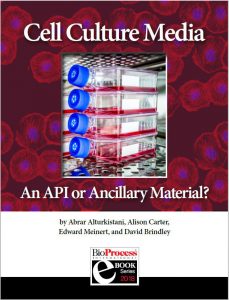 Cell-based therapies are used to treat diseases that require the replacement of diseased, dysfunctional, and injured cells (1). To produce these therapies, a wide range of reagents and materials such as antibodies, growth factors, and enzymes are used in their manufacturing processes. Such necessary materials are administered through a cell culture medium. Active pharmaceutical ingredients (APIs) are the main ingredients that make products therapeutic. Ancillary materials (AMs) and raw materials (RMs) are essential components used during production but are not supposed to be present in final products. Some advances in cell-based therapies have revealed inconsistencies and lack of regulation in classifying materials that are used to produce these products as RMs, AMs, and APIs. Clear guidelines and regulations are needed regarding RMs and AMs in cell-based therapies.
Cell-based therapies are used to treat diseases that require the replacement of diseased, dysfunctional, and injured cells (1). To produce these therapies, a wide range of reagents and materials such as antibodies, growth factors, and enzymes are used in their manufacturing processes. Such necessary materials are administered through a cell culture medium. Active pharmaceutical ingredients (APIs) are the main ingredients that make products therapeutic. Ancillary materials (AMs) and raw materials (RMs) are essential components used during production but are not supposed to be present in final products. Some advances in cell-based therapies have revealed inconsistencies and lack of regulation in classifying materials that are used to produce these products as RMs, AMs, and APIs. Clear guidelines and regulations are needed regarding RMs and AMs in cell-based therapies.
In cell therapy products, cells are cultivated in a cell culture medium, which contains all materials that are essential for cell growth and proliferation, including growth factors, hormones, and other necessary factors (2). Cell culture has many uses in the development of cell-based therapies. For example, it can be used to grow more effective and efficient influenza vaccines (3, 4). Cell culture medium is involved in cell-therapy manufacturing through the transfer of starting materials (tissue or cells) to a cell culture that contains growth factors and serum, followed by cell selection and the development of a cell therapy product (5). So cell culture medium is an essential product that allows the development of cell-based therapies.
An API is the main component of a pharmaceutical drug and the active ingredient of a drug product (6). This active ingredient creates the intended effects of a drug. An API starting material is a raw material, intermediate, or an API that is involved in the production of an API and is part of the essential “fragments” that make an API (6). APIs are essential for making pharmaceutical products and generally have welldefined guidelines for use.
Other than APIs, cell-based therapies are manufactured using raw materials (RMs) and ancillary materials (AMs). A raw material is a general term that refers to “starting materials, reagents, solvents, process aids, intermediates, APIs, and packaging and labeling materials” (6). AMs are materials or products that come into contact with pharmaceutical products during manufacturing but are not supposed to be in final products (7, 8). AMs and RMs are used to produce final APIs. AMs can be reagents such as enzymes, anticoagulants, buffer solutions, and culture media as well as containers or transfer devices such as bags, pipettes, needles, and culture flasks (8).
Although the industry refers to cell culture media as neither APIs nor significant structural fragments of APIs, determinations about whether cell culture media should be considered RMs or AMs have been inconsistent. That inconsistency stems from a tendency for regulatory agencies to disregard the difference between RMs and AMs and the lack of a consistent definition for AMs. The industry also suffers from inconsistencies in RMs for manufacturing cell and gene therapies (9).
Just fill out the form to download this eBook now.
